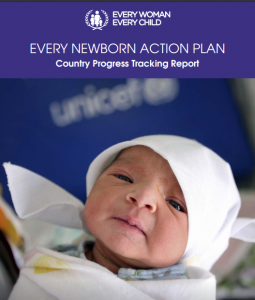
- Download the tracking report
- Download the report supplementary materials
- Download the country progress tracking submissions
The global Every Newborn Action Plan (ENAP), launched in 2014, includes clear targets and strategies for reducing neonatal deaths and stillbirths and supports the United Nations Secretary-General’s Every Woman Every Child initiative (EWEC). The explicit focus of new Global Strategy for Women Children and Adolescents is a great opportunity to integrate and adapt ENAP progress tracking in line with the monitoring framework for Global Strategy in 2016. The ENAP management team will review the need of process tracking from time to time to meet the needs of countries. A global ENAP partnership with three streams of work − country implementation, advocacy and metrics − was established to provide support for the achievement of the targets and milestones specified in the plan.
The Country Implementation Group (CIG) for ENAP, co-chaired by the World Health Organization (WHO) and UNICEF, has focused its attention on tracking progress and providing technical assistance to countries for effective implementation of the plan.
All countries are being supported in their ENAP implementation through the country, regional and HQ offices of partner agencies. Twenty-eight countries were chosen by CIG as ‘focus countries’ on the basis of their high burden of neonatal and maternal mortality (Annex I) and pro-active engagement during the ENAP development process.1 These focus countries have been targeted for data collection through the use of a progress tracking tool jointly developed by CIG partners. This systematic tracking of progress enables the assessment of the status of implementation of ENAP strategies, maps technical assistance needs and identifies barriers to implementation in line with the ENAP milestones and recommendations. The tool also aims to provide information to country, regional and global partners in order to facilitate and harmonize country technical support.
A tracking tool was first developed in 2014, and data were collected from 10 countries in the last quarter of the year. The tool was later revised by June 2015 and shared with all 28 focus countries for their input. Sixteen focus countries had completed the tool by the end of November 2015 as well as two additional countries Cameroon and Namibia. This report provides an analysis of the information for the individual countries and trends seen across countries.